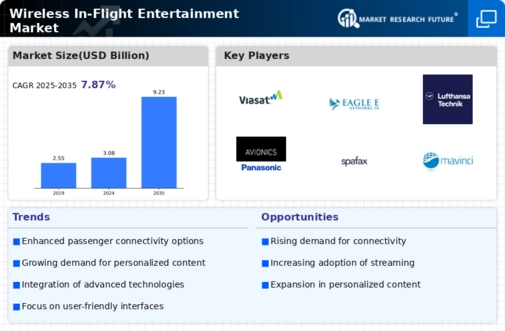Rising Passenger Expectations
The Wireless In-Flight Entertainment Market is experiencing a notable shift as passenger expectations continue to rise. Travelers increasingly seek personalized and engaging experiences during flights, which has led airlines to invest in advanced wireless entertainment systems. According to recent data, approximately 70% of passengers express a preference for in-flight entertainment options that allow for customization. This trend suggests that airlines must adapt their offerings to meet these evolving demands, potentially enhancing customer satisfaction and loyalty. As a result, the Wireless In-Flight Entertainment Market is likely to see a surge innovative solutions that cater to individual preferences, thereby driving growth in this sector.
Growing Demand for On-Demand Content
The demand for on-demand content is reshaping the Wireless In-Flight Entertainment Market. Passengers are increasingly favoring the ability to choose their entertainment options, leading to a shift from traditional linear programming to on-demand services. Recent surveys indicate that over 60% of travelers prefer to select their movies and shows rather than watching pre-selected content. This trend is prompting airlines to enhance their wireless entertainment offerings, ensuring that a diverse range of on-demand content is available. Consequently, the Wireless In-Flight Entertainment Market is likely to expand as airlines respond to this growing demand, providing passengers with a more tailored and enjoyable in-flight experience.
Competitive Differentiation Among Airlines
In the highly competitive landscape of the Wireless In-Flight Entertainment Market, airlines are increasingly recognizing the need for differentiation. As more carriers adopt wireless entertainment systems, the ability to offer unique and superior in-flight experiences becomes paramount. Airlines are investing in exclusive content partnerships and innovative features to stand out in the market. For instance, some airlines have begun to offer live television and on-demand movies, which can enhance the overall travel experience. This competitive drive is expected to propel the Wireless In-Flight Entertainment Market forward, as airlines strive to attract and retain customers through enhanced entertainment offerings.
Technological Advancements in Connectivity
Technological advancements play a crucial role in shaping the Wireless In-Flight Entertainment Market. The integration of high-speed satellite and air-to-ground connectivity solutions has transformed the in-flight experience, enabling seamless streaming of content. Recent statistics indicate that the market for in-flight connectivity is projected to reach USD 5 billion by 2026, highlighting the increasing importance of reliable internet access during flights. This connectivity not only enhances the entertainment experience but also allows airlines to offer additional services, such as real-time flight information and shopping options. Consequently, the Wireless In-Flight Entertainment Market is poised for significant growth as airlines leverage these technologies to improve passenger engagement.
Regulatory Support for In-Flight Connectivity
Regulatory support is emerging as a significant driver for the Wireless In-Flight Entertainment Market. Governments and aviation authorities are increasingly recognizing the importance of in-flight connectivity and are implementing policies that facilitate its growth. For example, recent regulatory changes have allowed airlines to offer Wi-Fi services without the need for extensive approvals, thereby streamlining the process. This supportive environment is likely to encourage more airlines to invest in wireless entertainment systems, ultimately benefiting passengers. As a result, the Wireless In-Flight Entertainment Market may witness accelerated growth due to these favorable regulatory developments.


















Leave a Comment